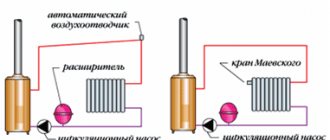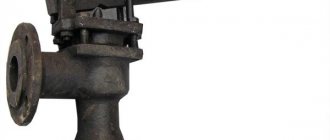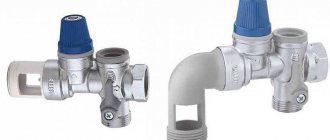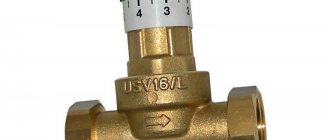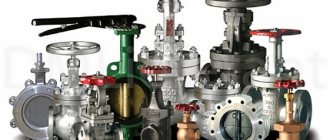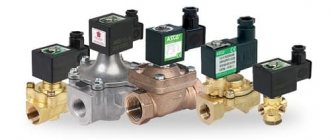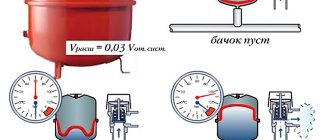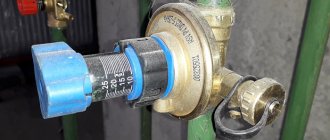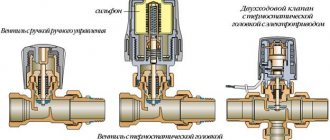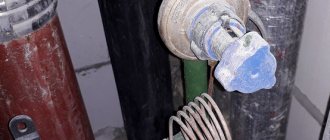For what purposes is the valve used?
In order to avoid situations with battery rupture, two devices are used in the heating system: a pressure gauge and a valve. The first device is designed to visually indicate the pressure that is in the system at any given time.
As for the valve for releasing excess pressure of water or other coolant, it serves to automatically prevent an accident. This helps a lot if at the moment of a pressure surge people do not see the readings.
As is clear from the name of the device, it is obliged to relieve the system of excess pressure during its operation. But not everyone understands what excess pressure is.
The fact is that a certain amount of bar in the system is always present for which the elements are designed. When purchasing, they also take into account possible excess pressure so that pipes and radiators can cope with it.
However, the pressure does not always exceed the limit that was taken into account when installing the equipment. So, the valve begins to release pressure as soon as it exceeds a constant norm.
If the excess reaches the limit of what is excessively provided, then the pipes will simply begin to burst.
Thus, the valve protects against the possibility of an emergency condition. It is used not only in the heating system, but wherever there is pressure in the system.
Excess pressure relief valve: types, device, principle of operation
There are two types of “demolition” - lever-load and spring. Lever-load units are not used in heating private houses, so it makes no sense to consider them. Let's talk about spring "resetters". We see their structure in section in the figure below.
Spring safety valve device for heating system
A shut-off and control element or a valve itself is inserted into the metal body, which takes on the pressure of the coolant. It is pressed by a spring, the elastic force of which is designed for a certain load. When the pressure in the heating system acts on the valve with a force greater than the force of the spring, it begins to compress and the disk rises. A certain amount of coolant is drained into the opened gap, the pressure drops, and the spring blocks the flow. This is how the overpressure relief valve works.
What does the device consist of and how does it work?
The relief valve is a device in a metal casing made of brass or stainless steel. Inside the device there is a rod with a spring connected to a special membrane, on which the working medium directly presses, but under normal hydrodynamic parameters it is opposed by a spring that keeps the membrane closed.
The equipment operates on the principle of direct action: the working medium, as the temperature rises and the volume increases, presses on a spring, which opens the hole and releases excess hot water until the pressure returns to normal. After this, the spring presses on the membrane in the opposite direction, blocking the outflow of the working medium.
We recommend that you read: Using paint for the surface of galvanized pipes
Thus, as soon as the water pressure in the system rises above a critical level, the spring compresses, opening a passage hole to discharge excess water. After briefly draining the hot water, the pressure in the system normalizes and the spring is activated, closing the valve.
In addition to the automatic mechanism based on spring actuation, the valve has a handle for manual water release, which allows the user to independently drain a small amount of heated coolant when the pressure gauge readings approach critical.
Important! The dumping device is installed only on the supply section of the heating system no further than 50 cm from the boiler. Do not install any foreign devices between the boiler and the valve (taps, valves, diverters, etc.)
Purpose of a safety valve in a heating system
Adjustable spring safety valve.
Most often used in individual heating systems. An increase in the temperature of the coolant in the heating water circuit leads to an increase in the pressure exerted on the walls of the system. Particularly critical are temperatures above 90-95°C, when water begins to boil, releasing steam. The pressure in the system increases exponentially. If modern pipes and radiators are designed, as a rule, for a pressure of 6-9 bar or more, then the most vulnerable point of the system is the boiler heat exchangers, which in modern models can withstand pressures of up to 3 bar, and in older models even 2 bar.
Subsequently, not just a heat exchanger leak may occur, but also a short circuit or a serious flood due to leakage of large volumes of coolant.
The safety valve ensures the automatic release of steam or coolant, freeing up space in the system for expansion due to heating, which prevents the pressure inside the water circuit from reaching critical values. After the pressure is released, the valve also closes automatically. The valve is inserted into the pipeline near the boiler itself, often a pressure gauge and an automatic air vent are also installed with it; together this complex is called a safety group.
The principle of preventing critical pressure levels in the heating system using a safety valve.
If modern models of gas and electric boilers, thanks to advanced automation, are able to prevent overheating, at least by simply turning off the burners in a timely manner, then for solid fuel boilers the installation of a safety valve is mandatory. Even after closing the damper, the heat exchanger in the solid fuel boiler continues to receive heat for some time. It is precisely because of the inertia of the heat generator that serious overheating can occur.
A relief valve is also mandatory for steam boilers (usually used for industrial purposes). However, we recommend installing a safety valve into the heating system with any boiler, including gas, installing the valve as part of the safety group.
Please note that for large volumes of the heating system (for example, designed to heat a house over 500-600 m2), it is recommended to install 2 safety valves on each boiler - a working one and a control one.
Advantages and disadvantages
The relief valve has the following advantages:
- eliminates water hammer and pressure surges;
- prevent the appearance of air pockets in the liquid media transportation system;
- simple design that is easy to maintain and repair;
- relatively low cost;
- possibility of automatic control and pressure release;
- simple installation technology;
- unpretentiousness to operating conditions;
- do not require frequent maintenance.
Flaws:
- presence of operating error;
- increased wear of critical parts;
- limited service life.
Simple valve design
Operating principle
Most ordinary users faced with closed water heating systems are familiar with only one type of safety valve - a simple spring valve with a fixed setting, shown in the photo. The reason is clear - these elements are installed everywhere on any boilers, since they are part of the safety group along with a pressure gauge and an air vent.
Note. Wall-mounted heat generators operating on electricity and natural gas are equipped with safety elements from the factory. They are placed inside the case and are not visible from the outside.
Let's understand how a regular emergency valve works, shown in the diagram above:
- Under normal conditions, the diaphragm, attached to the stem and supported by a spring, sits tightly in the seat and seals the passage.
- If the coolant overheats, it expands and creates excess pressure in a closed system, partially compensated by the expansion tank.
- When the amount of water pressure reaches the valve response threshold (usually 3 Bar), the spring is compressed under its influence and the membrane opens the passage. The boiling coolant is automatically discharged until the spring has enough strength to close the flow area again.
- In the event of an emergency, the owner of the house can relieve excess pressure himself by turning the handle at the top of the product.
A few words about where the relief valve is installed along with the safety group in a closed heating system. Its place is on the supply line in the immediate vicinity of the boiler (recommended no further than 0.5 m).
The safety unit is always installed on the heater flow line
Important point. It is prohibited to install taps, valves and other shut-off devices on the pipeline leading from the heat generator to the safety elements.
You should not tightly connect the pipe of the product to the sewer - wet spots or puddles will indicate the valve has been activated and problems in the heating network. For example, the expansion tank failed or the circulation pump malfunctioned when working with a solid fuel boiler (the electricity may have been turned off). Often the device begins to leak due to debris getting between the seat and the plate. More about his work is described in the video:
Watch this video on YouTube
Additional information. Masters and installers call spring relief valves blasting valves because the pressure of the coolant compresses the spring and causes the membrane to explode. Do not confuse them with explosive elements installed on the chimneys of industrial boiler houses that burn natural gas.
Purpose and installation location
Closed heating systems operate under a certain pressure.
A significant increase in operating pressure leads to equipment failure. Connections may leak, plastic parts and elements may burst. In the most unfavorable situations, the boiler heat exchanger may explode. This is already very dangerous and threatens not only the floor flooded with hot coolant, but also burns. After all, the temperature is serious. The overpressure relief valve must protect the heating system from excessively high pressure. As long as the system parameters are within normal limits, it does not manifest itself in any way. Although the pressure in the system gradually increases from the moment the boiler starts, the expansion tank compensates for it, maintaining a stable state of the system. But it may not do this indefinitely, although, with proper calculation, it is enough for standard situations. If the expander fails to cope with the task, the pressure begins to rise. When it exceeds the threshold, the excess pressure relief valve is activated. It simply releases part of the coolant, thereby stabilizing the emergency situation.
That is, the excess pressure relief valve in the heating system works in emergency situations. That is why it is also called “emergency”. And also “discharge”, “drain”, “protective” and “explosive”. All these are names of the same device.
What does a safety (emergency) valve for heating look like?
As is clear from the description, when the pressure increases above a certain limit, a certain amount of coolant is simply released from the system. If you came to the boiler room and a puddle formed under the emergency valve, it means there was an emergency situation during which the pressure increased. No other alarm
So these traces are worth paying attention to. It is worth immediately checking the functionality of the valve itself and the membrane tank
Most likely, they are the reason. If you do not pay attention to these symptoms, after a while you may encounter problems: either something will “fly” in the system, or the water heating boiler will rupture.
Installation location of the emergency heating valve - on the supply pipeline, near the boiler
Of all the equipment in an individual heating system, the most dangerous is the boiler. Therefore, the excess pressure relief valve is installed either directly on the boiler itself (if there is an appropriate outlet for installation) or on the supply line immediately after the boiler. The distance is small - 20-30 cm from the body. If the boiler does not have this type of fittings (indicated in the description), then it is installed in the so-called safety group or placed separately. The safety group is placed at the outlet from the supply line immediately after the boiler (before the first branch and any other device), on which a pressure gauge, automatic air vent and excess pressure relief valve are installed.
Types of overpressure relief valves
There are several generally accepted classifications of safety valves. Depending on the method of action, there are:
- direct-acting valves - devices are activated by direct action of the working medium on the spring mechanism;
- indirect action - operate under the influence of an external pressure source (hydraulic fluid or electric drive).
Based on the type of load on the membrane, the device is divided into the following types:
- cargo - the most common mechanism for adjusting the working pressure in the system;
- spring - the pressure of the working medium is counteracted by a lever that presses on the rod, holding it in the closed position;
- lever-spring – hybrid devices equipped with a spring and a lever mechanism;
- magnetic spring valves are indirectly acting valves equipped with an electromagnetic drive.
Modern manufacturers offer other types of excess pressure relief valves.
For example, there are thermal relief valves on the market that respond not to an increase in pressure, but to an increase in the temperature of the working environment. They may have a remote or built-in temperature sensor, which operates on the basis of a heat-sensitive liquid located in a bellows.
When the water temperature heats up to 95-100 degrees, the liquid in the capillary tube of the sensor flask puts pressure on the bellows, which opens the rod and drains the superheated water to normalize the pressure.
We recommend that you read: Which ball valves are best for water supply
According to the control method, the valves are divided into two groups: manual and automatic - they are controlled, respectively, manually or are activated automatically when the pressure of the working medium increases. In addition, there are regulated and unregulated. Adjustment allows you to set any water pressure threshold.
Depending on the type of working medium, there are water and air. The former remove excess liquid, the latter discharge excess gases from the system, preventing airing of circuits in closed heating systems.
There are also control valves equipped with a built-in thermostat, which changes the throughput of the device, slightly opening or completely blocking the outflow of the working medium. Such devices are usually installed at the entrance to the heating radiator in the room.
Element with remote sensor
The product is the same spring mechanism, built into a housing with two pipes for connection to the supply line and discharge into the sewer. The rod that opens the plate and the path for the coolant is moved by bellows (2 groups - main and reserve). When the water overheats (from 95 to 100 °C), they are pressed by a heat-sensitive liquid coming from the sensor flask through a capillary tube. The design of the safety element is shown in the figure:
The temperature valve is included in the piping of a solid fuel boiler in three ways:
- with cooling through the water circuit of the heat generator;
- the same, through a special emergency heat exchanger;
- coolant discharge with automatic replenishment.
The first diagram, shown below, is used for double-circuit heating systems that heat water for domestic hot water. When a sensor mounted under the casing of a TT boiler acts on the mechanism, hot water from the circuit is drained into the sewer, and cold water from the water supply takes its place. Whatever the causes of the accident, such a flow system will quickly cool the boiler jacket and prevent consequences.
The DHW coil of a double-circuit boiler can serve as both a heater and a cooler in case of overheating. For protection, just connect the thermal valve according to the diagram
Note. The publication uses diagrams from the CALEFFI brand, taken from the manufacturer’s official resource.
The second scheme is intended for heat generators with a built-in emergency heat exchanger for cooling in case of overheating. Such units are produced by European brands Atmos, Di Dietrich and others.
For an example of connecting a discharge element through a standard heat exchanger, see the video:
Watch this video on YouTube
The latter scheme can only be implemented in conjunction with an automatic make-up system, since here the valve discharges coolant and not cooling water.
As you can see, the manufacturer allows the installation of two emergency devices - for pressure (safety group) and for temperature (relief valve)
Warning. It is not recommended to use automatic make-up for wood-burning heaters with a cast iron firebox. The latter is afraid of temperature changes and can crack if a large amount of cold water is supplied to the return line.
Combination valves with system make-up
This bright representative of emergency valves is similar in principle to bypass valves and performs 3 functions at once:
- Discharge of overheated coolant from the boiler tank based on a signal from an external sensor.
- Efficient cooling of the heat generator.
- Automatic replenishment of the heating system with cold water.
The picture above shows the design of the product, where you can see that there are 2 plates installed on one rod, which simultaneously open 2 passages: the boiling coolant is discharged through the first, water flows through the second in the opposite direction and replenishes losses. The connection diagram for a combined bypass valve with a solid fuel boiler looks like this:
Note. If it is necessary to use such a device to cool a TT boiler with a cast iron heat exchanger, then the flow must be organized through an open expansion tank or an indirect heating boiler.
A bypass valve with a triple outlet works on the same combined principle, only it is built directly into the coolant supply pipeline near the heating unit. The bellows is located in the part of the body placed in the pipe. The discharge is carried out through the lower pipe, and a water supply and a make-up line are connected to the two upper ones. Such products are used when there is not enough free space in the boiler room.
This relief valve is designed to be installed in the supply line.
Types of safety valves
The traditional disruptive design described above is imperfect. The spring mechanism, driven by excessive pressure, is not accurate and may work late when the temperature in the boiler tank has reached 100 ° C or higher, that is, boiling has begun. Of course, you can try to adjust the product with a screw or change the settings (there are versions with an adjustment cap), but this does not always give the desired effect.
Point two: the safety valve for the boiler protects it from destruction, but not from overheating. After all, discharging the coolant does not allow cooling the heating unit if combustion in the furnace continues. And lastly: in open-type heating systems, such devices are generally useless, since the water in them can boil without increasing the pressure.
Leading manufacturers of heating fittings offer modern products that are free of the listed disadvantages - thermal relief valves. These protective elements react not to an increase in water pressure in the system, but to an increase in its temperature to a critical level. There are 3 types of such devices:
- waste with remote temperature sensor;
- combined device with temperature sensor and make-up circuit;
- the same with direct installation in the pipeline.
For reference. Here are the names of reliable brands whose emergency fittings can be safely purchased and used in private homes. These are manufacturers ICMA and CALEFFI (Italy), Herz Armaturen (Austria) and the world famous European brand Danfoss.
The principle of operation for all varieties is the same: a spring mechanism with a membrane (or two) is driven by a bellows with a heat-sensitive liquid that expands significantly when heated. In this way, the thermal relief valves react quite accurately when the critical temperature is reached. We invite you to consider each of them in more detail.
Element with remote sensor
The product is the same spring mechanism, built into a housing with two pipes for connection to the supply line and discharge into the sewer. The rod that opens the plate and the path for the coolant is moved by bellows (2 groups - main and reserve). When the water overheats (from 95 to 100 °C), they are pressed by a heat-sensitive liquid coming from the sensor flask through a capillary tube. The design of the safety element is shown in the figure:
The temperature valve is included in the piping of a solid fuel boiler in three ways:
- with cooling through the water circuit of the heat generator;
- the same, through a special emergency heat exchanger;
- coolant discharge with automatic replenishment.
The first diagram, shown below, is used for double-circuit heating systems that heat water for domestic hot water. When a sensor mounted under the casing of a TT boiler acts on the mechanism, hot water from the circuit is drained into the sewer, and cold water from the water supply takes its place. Whatever the causes of the accident, such a flow system will quickly cool the boiler jacket and prevent consequences.
The DHW coil of a double-circuit boiler can serve as both a heater and a cooler in case of overheating. For protection, just connect the thermal valve according to the diagram
Note. The publication uses diagrams from the CALEFFI brand, taken from the manufacturer’s official resource.
The second scheme is intended for heat generators with a built-in emergency heat exchanger for cooling in case of overheating. Such units are produced by European brands Atmos, Di Dietrich and others.
For an example of connecting a discharge element through a standard heat exchanger, see the video:
The latter scheme can only be implemented in conjunction with an automatic make-up system, since here the valve discharges coolant and not cooling water.
As you can see, the manufacturer allows the installation of two emergency devices - for pressure (safety group) and for temperature (relief valve)
Warning. It is not recommended to use automatic make-up for wood-burning heaters with a cast iron firebox. The latter is afraid of temperature changes and can crack if a large amount of cold water is supplied to the return line.
Combination valves with system make-up
This bright representative of emergency valves is similar in principle to bypass valves and performs 3 functions at once:
- Discharge of overheated coolant from the boiler tank based on a signal from an external sensor.
- Efficient cooling of the heat generator.
- Automatic replenishment of the heating system with cold water.
The picture above shows the design of the product, where you can see that there are 2 plates installed on one rod, which simultaneously open 2 passages: the boiling coolant is discharged through the first, water flows through the second in the opposite direction and replenishes losses. The connection diagram for a combined bypass valve with a solid fuel boiler looks like this:
Note. If it is necessary to use such a device to cool a TT boiler with a cast iron heat exchanger, then the flow must be organized through an open expansion tank or an indirect heating boiler.
A bypass valve with a triple outlet works on the same combined principle, only it is built directly into the coolant supply pipeline near the heating unit. The bellows is located in the part of the body placed in the pipe. The discharge is carried out through the lower pipe, and a water supply and a make-up line are connected to the two upper ones. Such products are used when there is not enough free space in the boiler room.
This relief valve is designed to be installed in the supply line.
How to choose a relief valve
Of course, in terms of purchase and installation costs, a traditional blasting valve will be cheaper than temperature devices. It will easily protect a closed heating system connected to a gas, diesel or electric boiler, because in the event of an accident they stop heating almost instantly. Another thing is a heat generator using wood and coal, which cannot go out immediately.
To successfully select a thermal relief or overpressure valve, follow these guidelines:
- When using any energy carriers other than solid fuel, feel free to buy a regular blasting device.
- Study the documentation of your heat source or boiler (depending on what needs to be protected) and select safety fittings according to the maximum permissible pressure indicated therein. Most heating equipment is designed for a limit of 3 Bar, although there are exceptions - Lithuanian Stropuva boilers can withstand only 2 Bar, and some Russian units (among the inexpensive ones) can withstand 1.5 Bar.
- To effectively cool wood-burning heat generators in the event of an accident, it is better to install one of the thermal relief valves. Their maximum operating pressure is 10 Bar.
- In open systems with a TT boiler, pressure relief is useless. Select a safety product that operates at a coolant temperature of 95–100 °C, suitable for your unit and recharge method.
Advice. Refrain from purchasing cheap safety valves from China. Not only is it unreliable, but it also leaks after the first explosion.
Watch this video on YouTube
In addition to models with fixed settings, there are valves with adjustable settings on sale. If you are not a heating professional, then you should not buy them, and there is no particular need.
How to choose a safety valve
The main criterion for choosing a safety device is the technical parameters of the heating system specified in the design documentation.
Most modern closed heating systems use standard direct acting brass safety valves.
They are suitable for installation in systems operating on diesel, gas or electric boilers. When a critical temperature and pressure is reached, the safety valve almost instantly stops further heating of the working environment and prevents an accident.
Simple brass safety valves are designed to exceed the pressure of the working medium up to 3-6 bar.
When choosing a valve for diesel, gas and electric boilers, you need to select safety devices that can withstand pressure 20-25% higher than the normal operating pressure in the system.
For solid fuel boilers operating on peat, briquettes or coal, you need to choose the type of waste dumps more carefully, because solid fuel cannot stop burning instantly and continues to heat water for some time after switching off.
They are suitable for modern thermal relief valves with a maximum operating pressure of 10 bar. The same applies to solid fuel boilers in open heating systems, in which relief valves work most effectively by responding to an increase in operating temperature rather than pressure.
Important! When choosing a safety device, be sure to study the technical documentation for the boiler equipment. Manufacturers usually specify the required maximum pressure and temperature specifications for which relief valves are purchased.
It is not advisable to choose cheap engineering equipment from Chinese manufacturers: it is usually not of high quality and quickly breaks down. An indicator of wear is an increase in the number of valve operations.
We recommend that you read: Thermostatic valve for heating and air conditioning systems
Rules for installation and operation of the device
To maximize system protection from overpressure, you must follow the rules for installing and operating the relief valve:
- the connection is made at the outlet pipe of the heating equipment;
- for installation, select the highest possible point of the pipeline;
- the discharge pipe must be connected to a discharge channel connected to the sewerage system;
- the diameter of the valve opening must correspond in area to the internal diameter of the pipe;
- the location of the control device is located in a place accessible for maintenance;
- It is recommended to use quick-release connections;
- if you need to connect pipes after installed valves, then the diameter of the outlet part must be equal to or exceed their cross-sectional area;
- when installing two pressure relief devices, the cross-section of the pipe must exceed the area of the passage openings by a total of 25%;
- It is prohibited to install tie-ins and branches of communications between the boiler and the valve;
- after installation work, you need to make sure that the valve opens at the specified parameters;
- Maintenance should be carried out strictly in accordance with the manufacturer's requirements.
During long-term operation, blockages form on the internal surfaces, which can negatively affect the valve response time. It is important to use special solutions to clean them. Alcohol or vinegar solutions are suitable for these purposes.
If leaks are noticed on the body, then installing plugs is strictly prohibited, as this can lead to emergency consequences. It is necessary to quickly replace the device by selecting the correct parameters.
To monitor the condition, configure and check the functionality of the valve, you need to use the readings of pressure gauges, temperature sensors and other instruments. This will allow you not to involve specialists, but to solve all the necessary problems yourself.
Installation Features
When installing a water relief valve, you should consider not only its characteristics, but also the work performed by the expansion tank. If it does not respond to increased pressure in the system, the fuse should operate to allow excess fluid to escape. Following the installation rules, the valve location should be at a distance of 30-40 cm from the boiler outlet pipe, and a pressure gauge should be built between them. Its readings serve as information about the condition of the heating circuit. Relief valve installation rules:
- 1. It is prohibited to install shut-off equipment in front of the device - valves, taps, etc.
- 2. To remove excess water, a drain tube is placed at the valve outlet. To do this, you can use a return or sewer connection.
- 3. The safety valve must be located at the highest point of the closed heating system.
In addition, the working condition of the mechanism should be checked regularly. For spring models, soldering of the plate to the walls of the housing may occur. This acts by exceeding the maximum pressure mark, which affects the timely operation of the valve in the heating system, due to which the device may not open the hole for the liquid to exit.
This often concerns the operating conditions of the heating reset fuse, and not the principle of its operation. But even with careful installation, unstable operation of the product may occur. If the emergency device is triggered frequently (6-8 times), it is recommended to replace it. This means that the mechanism has become unusable - the spring and plate have worn out. When installing a safety valve, the following should be taken into account :
- to what extent do its technical characteristics correspond to operational ones;
- correct connection;
- When installing, you should use traditional tow for pipes; FUM tape (fluoroplastic sealing material) does not withstand temperature effects, which can cause leaks.
It is important to know that if the valve is leaking, you cannot put a plug on it. This will lead to an emergency. You should purchase a new device that matches the operating water pressure and replace the old one.
Safety valve
The name of the device speaks for itself. Its main function is to relieve unexpected loads that may arise under certain circumstances. Plus additionally adjustable coolant flow.
By the way, it can be installed on any section of the pipeline
In this case, it is not the location that is important, but the ease of maintenance if such a need suddenly arises
Types of safety valves
- The simplest option is clutch fuses made of brass. Their design is simple - threads are cut on both sides, and the valve is a spring-loaded rod with an EPDM gasket. This is a direct-flow model, the valve of which opens under the pressure of the coolant flow. Back pressure is blocking the line. This is one of the cheapest devices, but it lasts a very long time, which is time-tested.
- There is another brass option, but with a more complex design, where the pipes are connected in perpendicular planes. It uses a stainless steel rod and spring. Install it directly after the circulation pump. The operating principle of such a device is quite simple. The coolant pressure compresses the spring, which begins to put pressure on the rod. It opens a channel through which the coolant is squeezed out of the system, saving it from ruptures of pipes and other elements. By the way, the maximum temperature that the valve can withstand is 120C.
- There are a large number of varieties of check valves, which are also included in the safety group. Their main function is to prevent a counterflow of coolant from occurring if the pressure in the system suddenly drops.
There are several main types - disk, ball, flag and others. But they are all divided into spring-loaded and springless. With the first, everything is clear - there the main emphasis is on the counterforce of the spring. The second type is when the locking element returns under the influence of its own mass.
Three way valves. This type of shut-off valve is installed in heating systems where low-temperature circuits are provided. For example, when the circuit has a condensing boiler. Currently, manufacturers produce this type of valve with manual switching or electric switching. In the second case, it is necessary to connect the device to an alternating current network with a voltage of 220 volts.
Installation progress
All products designed to relieve excess pressure are equipped with installation instructions that require careful study before starting installation work. First, disconnect the device from the mains and drain the water. Installation sequence:
remove a part of the pipe whose size is equal to the length of the device body;
- cut threads on the ends of pipes;
- cover them with tow or FUM tape;
- screw the valve onto the threaded part of the pipe;
- connect a hose to the second pipe of the product, which will be directed to the sewer;
- tighten the connections using an adjustable wrench;
- seal with a special paste;
- configure the device according to the passport values.
To extend the life of any heating system, you should include a protective group consisting of a fuse, a pressure gauge and a bleeder valve. It is advisable to install additional temperature sensors that turn off heating equipment or turn on an additional cooling system when the temperature of the coolant critically increases.
Required tools and materials
To install the valve you will need:
- adjustable wrench;
- fum - ribbon or tow;
- special paste for sealing joints.
Connection diagram
For example, let's look at the installation diagram of the device in front of the hot water heater in the apartment.
Connection
Based on the type of connection, the following types of devices are distinguished:
- Threaded. Used for small diameter pipelines and low pressures typical for domestic systems. Most convenient for installation and dismantling for possible repairs and maintenance.
- Flanged. It is used in medium and large diameter pipelines and can withstand high pressure. More difficult to install/dismantle.
- Welded. The most durable and airtight connection. It is used on main pipelines and especially critical high-pressure systems. The most difficult to install and dismantle.
Flanged and welded connections are rarely used in domestic systems.
Device
Typical emergency valve configurations include:
- Housing with inlet and outlet pipes. The working chamber and valve seat are molded into the cast body.
- The closing element is a disk, ball or cone, in the normal position pressed against the seat and closing the passage for the working medium.
- Rod - a rod to which a locking element is attached.
- An elastic element is a spring or (less commonly) a membrane that reacts to the pressure of the medium and, depending on it, changes its position in space. Applies pressure on the locking element.
- Adjustment element. Most often, it is an adjusting screw that changes the elasticity of the spring and the force of its pressure.
The device may contain additional elements, such as an electromagnetic or pneumatic drive, sensors, pressure gauges, control panels, etc.
The selection of a safety device for a specific application takes into account its design and parameters.
Advantages of using safety valves
Relief valves are widely used to prevent problems in high pressure systems. The advantages of using valves that normalize pressure in the system are obvious:
- Low price of the device with a long service life.
- Simplicity of design and ease of operation.
- Ease of installation and selection of operating settings.
- The variety of types and dimensions allows you to select the most suitable relief valve depending on the technical characteristics of the system.
- Ability to use devices in aggressive environments.
- Depending on the type of device, there are valves that are installed in both horizontal and vertical positions.
A safety valve is a relatively inexpensive and reliable element that is an essential part of any high-pressure system. The correct choice of safety device, professional installation, timely maintenance and troubleshooting will ensure uninterrupted operation of the system for a long time.
Source
Installation errors and possible problems
According to the service departments that come to correct the mistakes of home craftsmen, the following mistakes are most often made:
- Installation of shut-off valves between the protective device and the boiler.
- The valve location is too far from the boiler (more than a meter).
- Skewed, undertightened or overtightened threads.
A number of professional tips for troubleshooting possible problems:
- The valve allows fluid to pass at normal pressure. The reason is most often that it is clogged with rust particles or mineral deposits. It can be eliminated by washing the device in a strong vinegar solution for several hours. Installation of a mechanical cleaning filter is strictly recommended.
- If leakage continues, the gasket may be damaged or deformed. In this case, you will have to replace the entire device.
- If you have an apartment with plastic emergency appliances, it is better to replace them with ones made entirely of metal as soon as possible. The difference in price will be recouped many times over by the increased resource.
It is strictly forbidden to plug a leaking water pressure relief valve, hoping to fix it later. An accident can occur at any time and damage expensive equipment and pipelines.
Expert advice
- A blasting device with standard technical characteristics allows water to pass through even at low pressure levels when clogged. The problem can be solved by cleaning the body parts. To do this, the product must be dismantled and placed in a container with vinegar for 2 - 3 hours. Then rinse it with water until completely clean and install it in its original place, lubricating the connection area with alcohol.
- If the valve continues to leak even after cleaning, then most likely the rubber gasket resting on the seat is clogged with debris. It is easier to replace such a part than to clean it without deformation. Replacing the valve on the supply pipeline to the boiler can be seen in the video:
- A number of consumers quite reasonably doubt the durability of shut-off valves with plastic parts. They actually have a shorter service life, so it’s better to immediately buy ones with metal components. Such products are on average 100 - 150 rubles more expensive, but they last much longer.
- You cannot simply turn off the device, even if it is leaking. A huge number of heating boilers have failed precisely after installing the plug.
